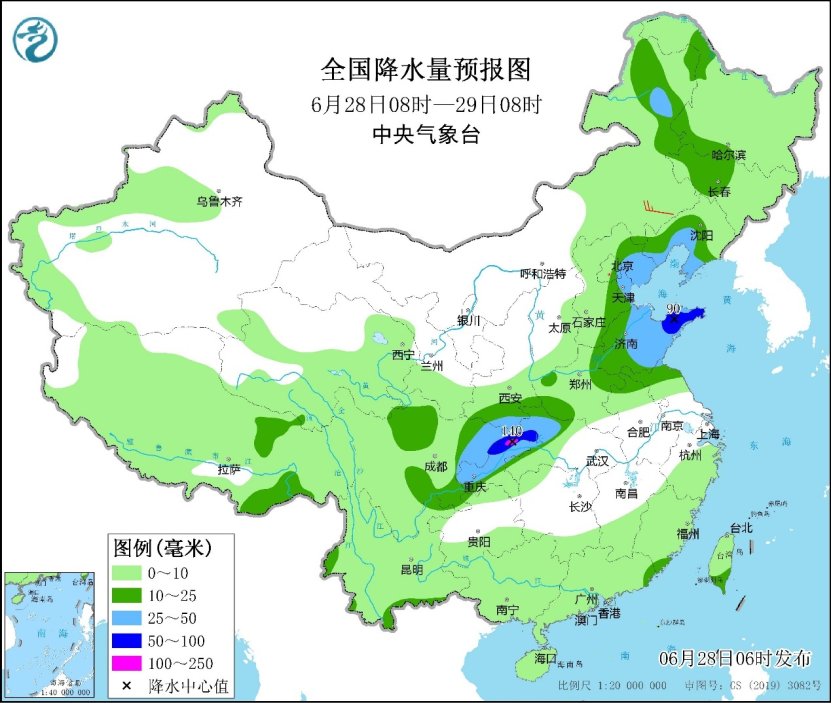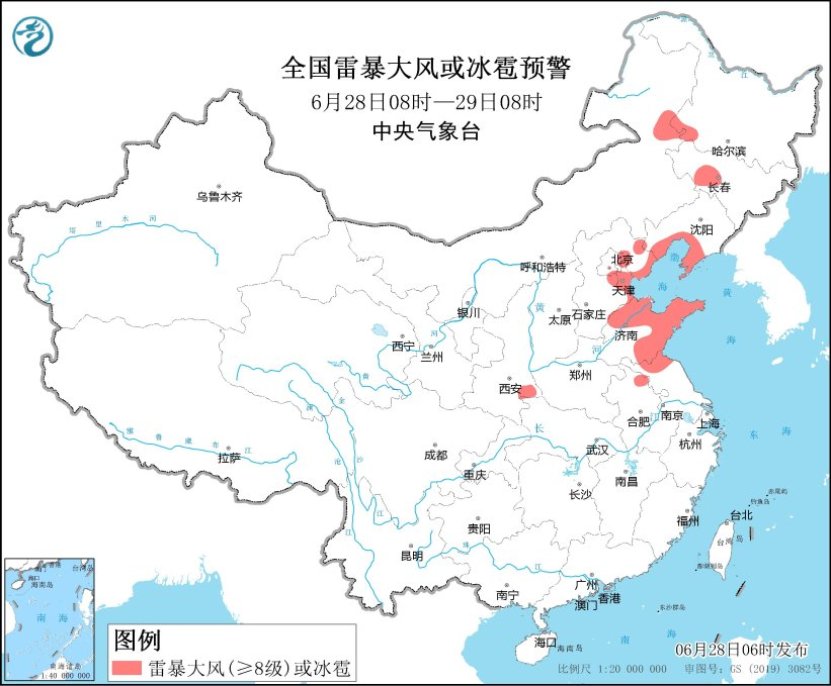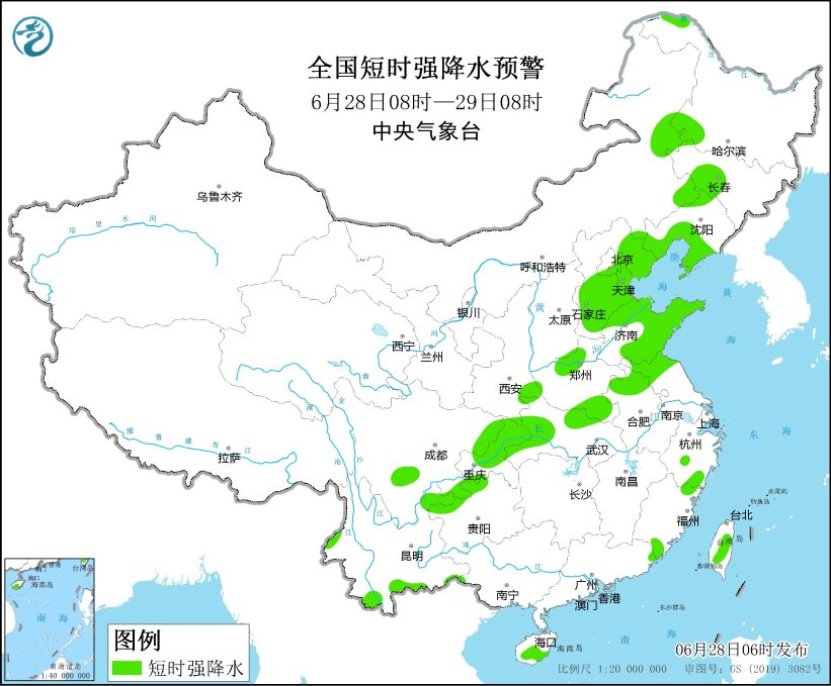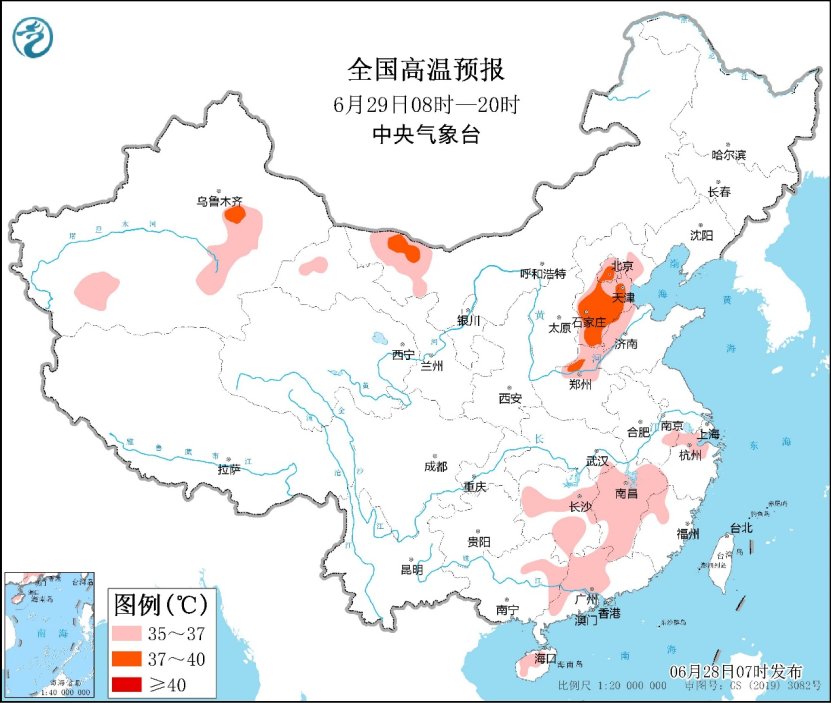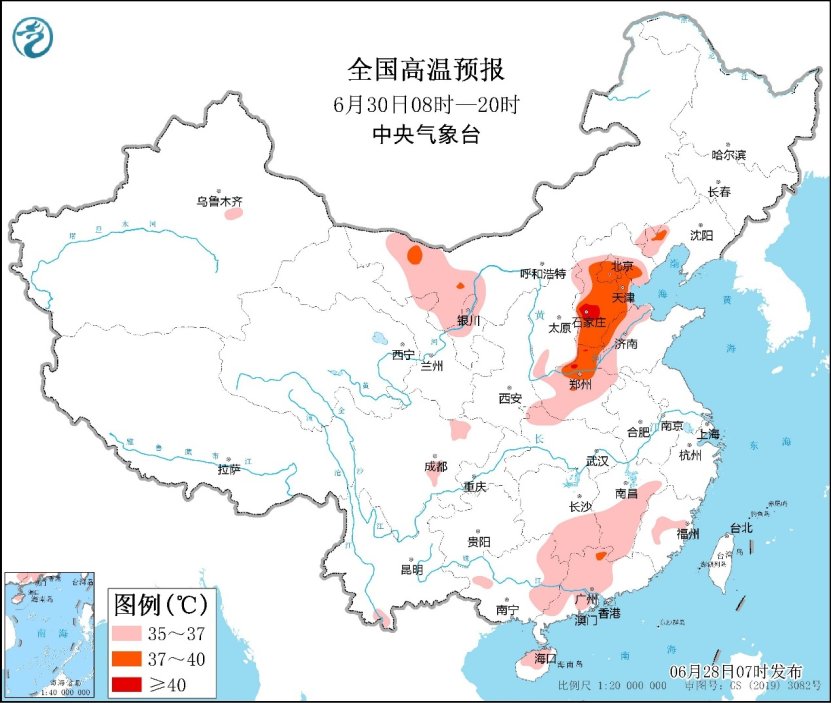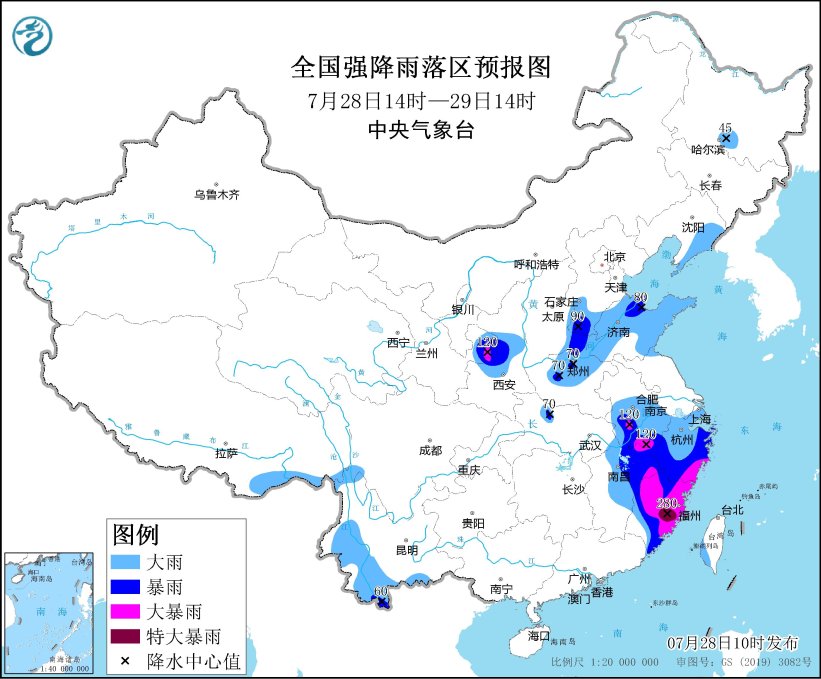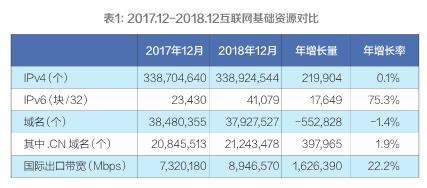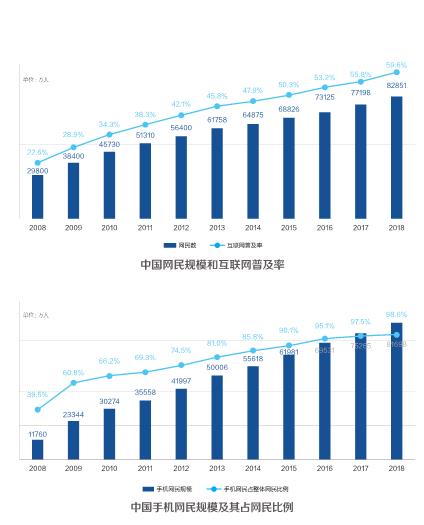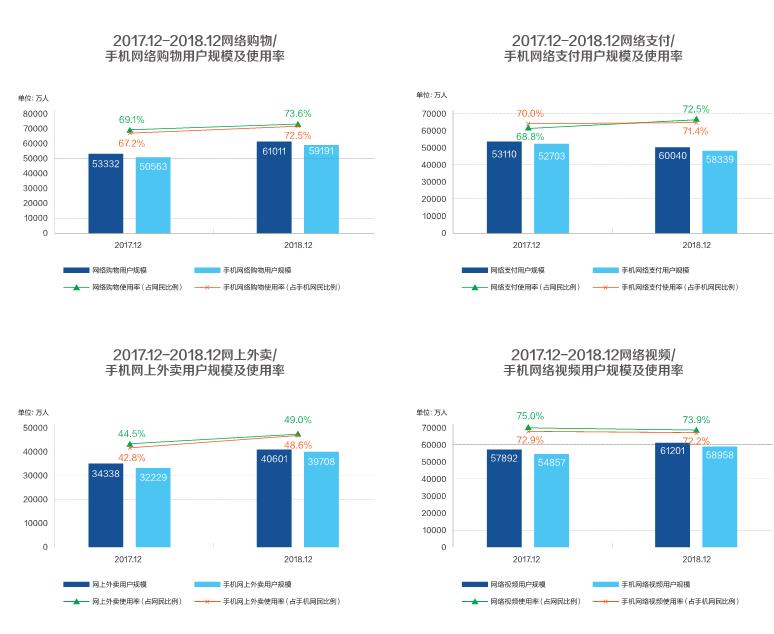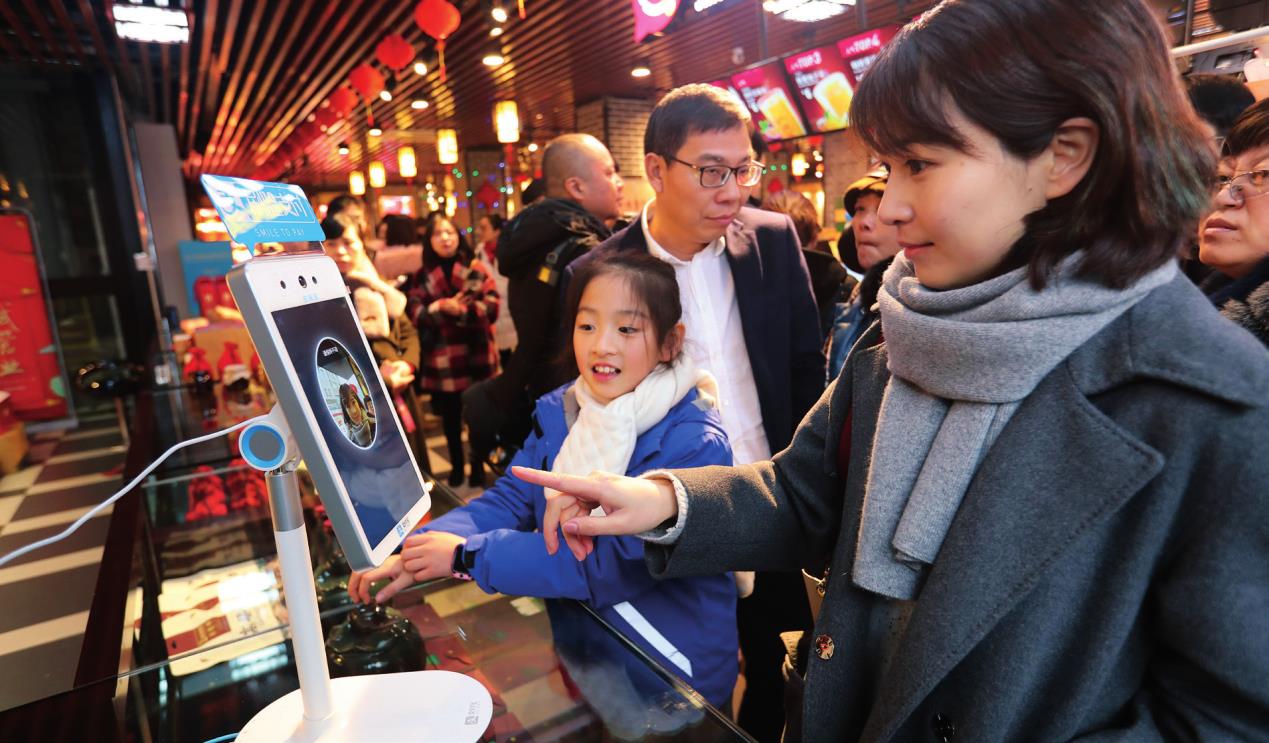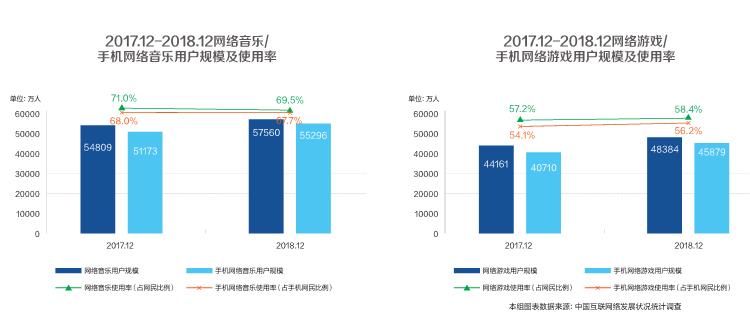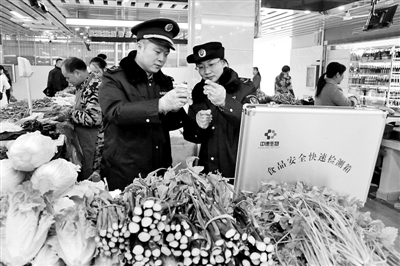
As the Spring Festival approaches, law enforcement officers of the Yushui District Market Supervision Bureau in Xinyu City, Jiangxi Province conduct on-site rapid detection of vegetable pesticide residues at Guanxia Smart Farmers Market. Photo by Liao Haijin/Bright Picture

A college student food festival was held in Shanghai. The picture shows the "fleshy" Mu Si cake as a dessert in the dining hall of Shanghai Ocean University. Xinhua news agency
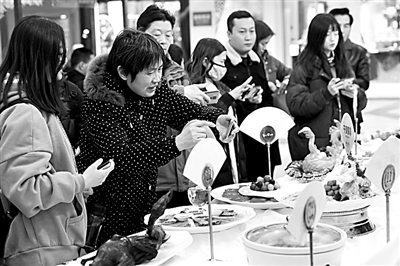
Citizens and tourists visit the Chongqing New Year Food Festival. Xinhua news agency
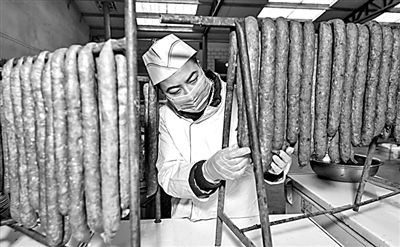
Villagers in Kangzhuang Village, Qukou Town, Xianghe County, Hebei Province are drying red and white sausages. Xinhua news agency
Is "artificial meat" edible? Is online celebrity food reliable? Are probiotics really useful? What foods have you paid attention to in the past 2019? What troubles have they brought you? Food safety concerns people’s health and life safety. At the "Media Communication Meeting on Scientific Interpretation of Food Safety and Health Hotspots in 2019", which was directed by China Association for Science and Technology and hosted by chinese institute of food science and technology recently, experts combed and interpreted the hot events of food safety that the public paid attention to in the past year, and made suggestions for food safety supervision by popularizing food safety knowledge through examples. This edition extracts some hot topics to interpret.
"artificial meat"
Scientific and technological problems to be solved, standards and regulations to be improved.
Interpretation expert: Wang Shouwei (Director of China Meat Food Comprehensive Research Center and Dean of Beijing Food Science Research Institute)
"Artificial meat" is synonymous with foods that are not naturally produced and have a similar taste to meat. It is usually divided into two categories: vegetable protein meat and cell cultured meat. The emergence of "artificial meat" on the one hand is to meet the rapidly growing meat demand of consumers, on the other hand, it provides a way to effectively reduce the land occupation of animal husbandry, the use of water resources and greenhouse gas emissions, and solve the problems of environmental protection and sustainable development.
In recent years, the processing technology of vegetable protein meat is becoming more and more mature at home and abroad, and many enterprises have developed vegetable protein meat products with vegetable protein as raw materials. The research on using animal stem cells to produce cells to cultivate meat has also made great progress, and many enterprises have announced that they can develop cells to cultivate meat in the laboratory. Vegetable protein meat has great market potential and a high degree of commercialization. In the future, developing products more similar to real meat has become a direction for the food industry and scientific and technological circles.
In the innovation and development of "artificial meat", it is necessary to increase scientific and technological input and solve the existing scientific and technological problems of "artificial meat". For example, research on the formation mechanism, raw material supply and processing technology of vegetable protein meat should be carried out to build a new research and development system. In the process of industrialization, we pay attention to improving the flavor, texture and nutrition of products, and constantly meet the increasingly diversified needs of consumers. Carry out research on the basic theory and key production technology of cell-cultured meat, and establish a production technology system of cell-cultured meat suitable for human food manufacturing.
While innovating and developing, adhering to product quality and safety is the foundation of the development of "artificial meat". It is suggested that the new ingredients and new production technology added in the production of "artificial meat" should be systematically evaluated for safety, and an independent standard system and an objective supervision system should be formed in the evaluation of product safety and nutritional components, so as to promote the benign development of the industry.
Scientific and rigorous standards are the cornerstone of the healthy development of the industry. In China, the development momentum of vegetable protein meat industry has been formed, and the product categories are relatively mature, but the existing laws and regulations are not suitable for product innovation and industry development; The development of its standard should be carried out as soon as possible, and the definition, classification method and production technology should be clearly defined, which will provide convenience for government supervision and provide reference for the direction of production and innovation of products in the industry. In addition, the research and development of cell-cultured meat in China is still in its infancy, but the development speed is very fast, and the research on standards and supervision methods has just begun; The division of supervisory responsibilities and division of labor system should be clarified, and a strict system of standards and laws should be formed. In addition, public science popularization should be carried out to guide consumers to correctly understand and rationally consume "artificial meat".
Online celebrity food
Strictly guard against the transformation of "red and black"
Interpretation expert: Ma Guansheng (Head of the Department of Nutrition and Food Hygiene, Peking University College of Public Health)
Some sellers make use of social media’s special publicity and marketing methods to dress up homemade food as "online celebrity" food, which is popular in the circle of friends. From home-made delicious food to home-brewed fruit wine, from morning tea snacks to midnight snacks, from beauty soup to dietary remedies, there are all kinds of foods in the circle. Online food attracts waves of consumers with its novel appearance, photos or taste. However, when consumers buy food, they often ignore the quality of the food itself, including raw materials, production date, shelf life and production address.
Due to the special sales channels (such as WeChat circle of friends, micro-stores), online celebrity food has some problems, such as difficult management and lack of effective supervision mechanism. Taking the incident of "there is no milk in milk tea" in online celebrity as an example, China’s national standard "Tea Beverage" (GB/T 21733-2008) defines milk tea drinks and milk tea-flavored drinks as liquid drinks prepared by taking water extract of tea or its concentrated solution and tea powder as raw materials and adding one or more of milk or dairy products, sugar and/or sweeteners, edible milk flavor essence, etc. Although there is a requirement for the protein content of milk tea in this standard (≥ 0.5%), but milk or dairy products are still only one of a variety of optional ingredients, not a hard requirement. Therefore, due to the lack of clear standards for existing milk tea, there is an embarrassing situation that "milk tea does not contain milk", which increases the maneuverability of merchants and brings blind spots to food safety supervision.
It is suggested to improve the supervision mechanism and clarify the responsibilities and supervision methods of all parties in the business activities of non-traditional foods such as online food sales. At the same time, strengthen regular sampling and random inspection, and urge network platforms and production operators to implement the main responsibility. Strike hard at illegal food safety behaviors in online sales, strictly investigate and deal with behaviors such as "brushing the bill" and "false comments", and protect consumers’ rights and safety with strict supervision.
Online celebrity food is mainly sold through the online platform, so the online platform should assume the responsibility of screening and supervision. The network platform should establish a mechanism to help the superior and limit the inferior, strictly control the entry threshold of merchants, inspect and regularly review their retail qualifications and relevant licenses for selling products, and prevent counterfeit and shoddy foods from being sold on the network platform. Food enterprises and individual food producers should strengthen the construction of industrial chain safety, ensure the safety and traceability of product sources, make the product chain clear, and prevent and control risks. As consumers themselves, they should constantly improve their health literacy and food safety literacy, make rational purchases, and not blindly "chase after the red".
probiotics
The efficacy has the specificity of strains and people.
Interpretation expert: Chen Wei (Academician of China Academy of Engineering, Chairman of Probiotics Branch of chinese institute of food science and technology, Vice President of Jiangnan University); He Guoqing (Vice Chairman of chinese institute of food science and technology Probiotics Branch, Professor of Zhejiang University)
Probiotics have a strict definition: they must be living microorganisms, which are beneficial to the health of the host when ingested in sufficient quantities. Moreover, the health function of probiotics should be based on scientific and rigorous clinical trial evaluation and evidence-based medical evidence. At present, tens of thousands of published academic papers have studied the functions of different probiotic strains, confirming that the core function of probiotics is to improve the health of human gastrointestinal tract. In addition, in vitro experiments such as cell model, animal experiments and human experiments show that probiotics may have potential beneficial functions to improve metabolism and nervous system. However, in vitro experiments and the actual human digestive system are completely different worlds, and the results of in vitro experiments can never be used to claim the functions of probiotics. Animal experiments can be used as a reference, but it needs to be confirmed by large-scale and deeper human or clinical experiments.
It is a long-term, rigorous and scientific process for human beings to explore the efficacy of probiotics. At present, there are various probiotic products with claimed functions on the market. However, it should be emphasized that the academic community has reached a consensus that the core function of probiotics is to improve gastrointestinal health.
Generally speaking, the mainstream probiotic strains in the market are all isolated from healthy people and fermented foods with a long history of safe use. Most of them are considered as non-pathogenic symbiotic microorganisms, and their safety has been recognized by authoritative organizations. Of course, for sick individuals, such as patients with severe infection or immunodeficiency, they should be used with caution or consult a doctor.
It should also be noted that the efficacy of probiotics has the specificity of strains and people. There are differences in probiotic efficacy among different strains; There are also differences in physiological regulation of probiotics among different hosts. Therefore, in the future, we should confirm the relevant probiotic functions at the strain level, judge and apply the individual functions of probiotics according to the individual characteristics of different hosts, and pay attention to personalized precise nutrition. Of course, the industrial application of probiotics must also be verified by scientific and rigorous processes. For example, the species, even the genetic composition and basic physiological and biochemical characteristics of the strain are first studied, and then the adaptability, safety and probiotic characteristics of the strain are evaluated in turn, and finally the probiotic dosage and probiotic combination with satisfactory efficacy are selected.
In addition, consumers should choose probiotic-related products scientifically and reasonably. For lactic acid bacteria drinks, consumers should pay attention to distinguish product types when purchasing. According to the relevant standards in China, the labels of lactic acid bacteria drinks should be marked with live bacteria (non-sterilization) or non-live bacteria (sterilization), and they can be distinguished by labels when purchasing. When consumers buy yogurt, they should keep it reasonably according to the label. Low-temperature yogurt should be sold in cold storage. When they return home after purchase, they should put it in the refrigerator as soon as possible and drink it in time to ensure its strain activity.
Probiotics have individual differences in their effects on health, and there is no "all-purpose" probiotic strain, which is suitable for everyone and all physical conditions. We should further strengthen the popular science education of consumers, popularize the professional knowledge of probiotics and clarify the scientific concept of "quantity" of probiotics, so that consumers can rationally choose probiotic products.
Self-heating food
It is necessary to cross the safety hurdle of "self-heating package"
Interpretation expert: Lu Fuping (Vice President of chinese institute of food science and technology and Vice President of Tianjin University of Science and Technology)
Self-heating food is a product that heats food with flameless self-heater and quickly reheates it to edible state. In recent years, a series of self-heating products represented by self-heating hot pot have developed rapidly. Besides the common self-heating hot pot and self-heating rice, there are also self-heating porridge, noodles, rice noodles, soup, etc., which are diverse and meet the urgent needs of consumers for hot food in more consumption scenarios.
Although the safety of self-heating food is generally controllable, the safety risk of "self-heating package" should be paid full attention to. Since self-heating food uses the chemical reaction between heating agent and water to generate heat to heat the food. Occasional phenomena such as "self-heated food rupture" or "unstable temperature of self-heated food" have aroused people’s concern about the safety of self-heated food.
Under the current self-heating technology in China, the chemical self-heating package used for self-heating food is mostly magnesium/iron for military use and aluminum-water for civilian use. No matter what kind of heating package, a small amount of hydrogen will be produced when heating. If individuals eat or a small number of people gather to eat, even in a closed environment, the amount of hydrogen generated by the heating of the heating package is far from the limit that can cause explosion. Under normal circumstances, the normal products will be eaten according to the normal operating procedures, and there will be no risk and safety problems such as cracking. However, if people eat a lot of self-heating food at the same time in a closed environment, or if the vent hole on the self-heating food packaging box is blocked, there may be potential safety hazards, which need to be paid full attention to.
It is suggested to increase the research on the safety of self-heating package and develop a self-heating package with high efficiency and good safety. By developing energy-efficient formula and new heating device, the generation of hydrogen and water vapor can be controlled or reduced, the demand for energy efficiency release and utilization can be improved, and the safety level can be improved. Develop a new type of physical self-heating device, use renewable energy and reduce pollution. In addition, it is necessary to enhance the effectiveness and support ability of the self-heating device in various scenarios.
The rapid development of self-heating food industry has attracted a large number of enterprises to join. However, due to the imperfect standards and specifications of self-heating food, the enterprises that have joined the self-heating food industry are mixed, which seriously affects the healthy development of the industry. At present, only the group standard "Self-heating Convenient Cuisine Products" issued by China Business Federation in 2017. From the perspective of regulating the industry, self-heating food needs more stringent standards to ensure its healthy development. It is understood that the industry is actively exploring how to establish a unified standard, for example, by standardizing the chemical composition and proportion, heating intensity, hydrogen production and other indicators contained in self-heating food heating packages, and making clear requirements for the treatment of final waste, so as to improve the entry threshold of the industry and standardize the healthy development of the industry.
Special medical food
Not for everyone
Interpretation expert: Ren Fazheng (Academician of China Academy of Engineering, Vice Chairman of chinese institute of food science and technology Probiotics Branch, Professor of China Agricultural University)
Special medical food is formula food for special medical use, which is specially processed and prepared to meet the special needs of people with limited eating, digestive and absorption disorders, metabolic disorders or specific disease States for nutrients or meals. It also has a very strict classification, which is currently divided into two categories: people aged from 0 months to 12 months and people over 1 year old.
On the basic functions of special medical food — — At present, there is a broad consensus on nutritional support, including improving the treatment and rehabilitation effect, shortening the course of disease, reducing medical expenses, increasing the turnover rate of hospital beds, and reducing the readmission rate, which can be solved through nutritional support and special medical food. The World Health Organization has proposed that if more money is invested in nutrition and health care, less 8.5 yuan can be spent on treatment and the cost of rescue in 100 yuan can be saved. It can be said that the nutritional support function of special medical food is indispensable in clinic. Of course, it can’t replace drugs.
Special medical food is a new industry in our country, and our government attaches great importance to it, and has made very strict management regulations at the beginning of the industry development. Special medical food should be registered by the food safety supervision and administration department of the State Council, and the formula of special medical food should be based on the research results of medicine and nutrition, and its safety and clinical application effect need to be scientifically confirmed.
According to news reports, some illegal enterprises produce ordinary solid drinks, pass off as special medical milk powder and mislead consumers. This kind of behavior belongs to false propaganda, which should be severely cracked down and strengthened management. In addition, when the special medical food is registered and put on record, the product formula and production technology are strictly regulated. Food enterprises should produce special medical food according to the registered formula, and cannot produce special medical food without obtaining the registered formula and production license.
The demand emphasizes that special medical food is special and not suitable for everyone. Moreover, different special people need different special medical foods. We should strengthen the popularization of special medical food, let consumers know its particularity and eat it according to the doctor’s advice.
Reduce salt, oil and sugar
Science and technology lead, scientific implementation
Interpretation expert: Chen Junshi (Academician of China Academy of Engineering, General Consultant of National Food Safety Risk Assessment Center)
The diet of Chinese residents is high in salt, oil and sugar. "Three reductions" is not an isolated matter, it is an important part of the whole reasonable diet. Whether it is the government supervision department, food industry or consumers, it is necessary to raise awareness and establish the concept of "reasonable diet".
Carrying out the "three reductions" action is not a matter for any department or enterprise, but should be coordinated and promoted by all parties. The government should formulate corresponding policies to lead the "three reductions" action, and catering and food processing enterprises should provide diversified products with different levels of salt, oil and sugar for consumers to choose by reducing the use of salt, oil and sugar. Residents gradually reduce the use of salt, oil and sugar in their daily cooking.
In particular, the food industry and catering industry should accelerate the transformation and upgrading of nutrition according to the health needs of consumers, and take the initiative to take measures to reduce the use of salt, oil and sugar in food. This requires increasing scientific and technological support, laying a solid scientific foundation, solving the problems such as product flavor change and shortened shelf life that may be caused by "three reductions", innovating and developing new foods, and leading a healthy transformation with science and technology. In addition, there are different dietary nutrition problems in different regions and different groups of people, so nutrition science education should be targeted and reflect differentiation. Nutrition intervention should be precise, and the implementation of policies should be based on science and practical. Focus on guiding enterprises to provide more differentiated products for consumers to choose, and guide consumers to choose products that suit them reasonably.
The action of "three reductions" needs to be carried out step by step in line with China’s national conditions, instead of "eating a fat man at one breath". It takes time to change people’s tastes, not quick. The improvement of cooking, methods and food processing technology also takes time, which cannot be achieved overnight, and should be carried out step by step in accordance with scientific laws. The transformation of consumer health concept needs long-term positive guidance and popularization of scientific knowledge. Therefore, the implementation of the "three reductions" action must be gradual, and various problems must be solved step by step.
Food fraud
Counterfeiting detection technology needs to be upgraded
Interpretation expert: Wu Yongning (Chairman of chinese institute of food science and technology Food Authenticity and Traceability Branch, Technical Chief of National Food Safety Risk Assessment Center); Chen Ying (Vice President and Chief Engineer of China Academy of Inspection and Quarantine)
Food quality, food safety and food truth are three attributes of food. The authenticity problems such as food fraud and forgery exist at home and abroad. For example, as the saying goes in China, "selling dog meat by hanging sheep’s head" and the "horse meat passing off as beef" that happened in Europe a few years ago. The World Health Organization once pointed out that apart from food-borne diseases, more and more food fraud and food fraud problems need to be paid attention to.
Ensuring the authenticity of food is not only to protect public health, but also a necessary measure to curb the market chaos of "bad money drives out good money", standardize the market competition order and boost food consumption confidence. At present, China has basically met the public’s requirements for the quantity and quality of food, and the concern for food safety has reached a higher level. However, for a long time, the investment in food authenticity technology is relatively lacking, and it is difficult to guarantee the scientific supervision of "food authenticity". If food fraud is "a magic height of one foot", then the detection technology of counterfeit identification must be "a magic height of one foot".
It is suggested to increase the scientific and technological investment in food authenticity research and overcome the technical difficulties and supervision problems of food authenticity. At the same time, speed up the transformation of technical standards of food authenticity, formulate corresponding detection methods and standards, and provide technical support for scientific supervision of food authenticity in China.
(This edition of the article was compiled by our reporter Chen Haibo)








